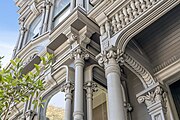Building at 1735–1737 Webster Street | |
 | |
| Location | 1735–1737 Webster Street, San Francisco, California, U.S. |
|---|---|
| Coordinates | 37°47′13″N122°25′55″W / 37.786899363905775°N 122.43190975433838°W |
| Area | 0.1 acres (0.040 ha) |
| Built | 1876 |
| Architect | Newsom Brothers |
| Architectural style | Stick/Eastlake |
| NRHP reference No. | 73000444 [1] |
| CHISL No. | N206 |
| Significant dates | |
| Added to NRHP | March 8, 1973 |
| Designated CHISL | March 8, 1973 [2] |
The Vollmer House is a historic house built between 1876 and 1885, and located in the Japantown area in San Francisco, California. The house is known for its outstanding decorative details on the exterior.
Contents
It was listed as a California Historical Landmark since March 8, 1973; [3] and on the National Register of Historic Places as "Building at 1735–1737 Webster Street" on March 8, 1973. [1] [4] This building is near the Bush Street–Cottage Row Historic District.








